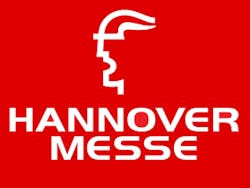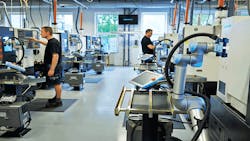Industry 4.0, industrial robots & 3D printing are on the cusp of changing how manufacturing is done
We love predictions. We love the way they create awe-inspiring futures that we either welcome with great anticipation or fear with crippling horror. The bigger and bolder, the better. If it’s the future, it undoubtedly will be spectacular.
I still remember sitting in Mr. Carls’ fifth-grade class at St. Patrick Grade School when he informed us all that we would be alive in the year 2000. We all gasped and marveled at a time so distant, when summers would surely last forever and bubble gum would be free. Oh, how lucky we would be to live in the year 2000.
Dr. Irene Petrick, market innovation director, Internet-of-Things Group at Intel, will present details about the "Industry 4.0 Demands the Co-Evolution of Workers and Manufacturing Operations” study and how factories and manufacturing plants can better handle the transition to intelligent facilities at Hannover Messe on April 27 at 10 am in Hall 8, Stand D17.
Now that we’ve chugged past Y2K, not to mention the uneventful slide right through the end of the Mayan calendar in 2012, we seem to have steered clear of destruction and are headed straight toward a future of self-flying cars (finally!) and underwater coastal cities, thanks to the rising oceans as the polar ice caps melt. The future has never loomed larger.
Data and communication are sure to play a huge role in that future. There’s no limit to the power of information and the algorithms and artificial intelligence that can turn it into actionable heroics. A recent report, "Industry 4.0 Demands the Co-Evolution of Workers and Manufacturing Operations," penned by Dr. Irene Petrick, market innovation director, and Dr. Faith McCreary, principal engineer, Internet-of-Things Group at Intel, indicates that Industry 4.0 and the Industrial Internet of Things (IIoT) are quickly altering how products are manufactured. But, according to authors, who collected information from 145 manufacturing professionals, “When we envision intelligent factories of the future, we often put technology in a starring role, but technology alone will not ensure a successful transition to an intelligent factory.” The success of that transition is in the hands of factory personnel.
“Fully 98% of the workers who participated believed that they had direct or indirect influence over technology adoption and implementation decisions. These individuals are potential allies in the path to the future, if only we can harness their interest in change,” according to the report.
As many employees fear the impact of technology, futurists see a different path. The London School of Economics (LSE) published a study entitled, “Robots at Work,” on the use of industrial robots. “Productivity has improved by around 15% due to industrial robots,” said Guy Michaels, LSE’s head of research. “At the same time, the proportion of low-skilled labor dropped, and pay increased slightly. Industrial robots don’t have any significant impact on the number of employees overall.”
A recent study by the Centre for European Economic Research on behalf of the German Federal Ministry for Education and Research revealed similar findings in the country with the world’s third-densest industrial robot workforce. The number of people employed in Germany reached 44 million in 2017, the highest figure since reunification (Figure 1). And the rapid spread of industrial robots hasn’t made a dent in employment figures.
Figure 1: Workers use robots to carry out machine tending mainly on CNC machines.
(Source: Universal Robots)
“The modernization of production shifts hazardous, unhealthy and monotonous work to the machines,” explains Junji Tsuda, president of the International Federation of Robotics. “In the vast majority of cases, only certain activities of a job are automated and not the entire spectrum of an employee’s work.”
As much as big data and industrial robots may change manufacturing, 3D printing could make an even bigger ripple, with its localized production and batch-of-one capabilities. No one knows what lies in store, but, like death and taxes, technology is inevitable. Buckle up. Here comes the future.
ALSO READ: Congratulations, your job has just been automated
Mike Bacidore is the editor in chief for Control Design magazine. He is an award-winning columnist, earning a Gold Regional Award and a Silver National Award from the American Society of Business Publication Editors. Email him at [email protected].
About the Author
Mike Bacidore
Editor in Chief
Mike Bacidore is chief editor of Control Design and has been an integral part of the Endeavor Business Media editorial team since 2007. Previously, he was editorial director at Hughes Communications and a portfolio manager of the human resources and labor law areas at Wolters Kluwer. Bacidore holds a BA from the University of Illinois and an MBA from Lake Forest Graduate School of Management. He is an award-winning columnist, earning multiple regional and national awards from the American Society of Business Publication Editors. He may be reached at [email protected]

Leaders relevant to this article:




